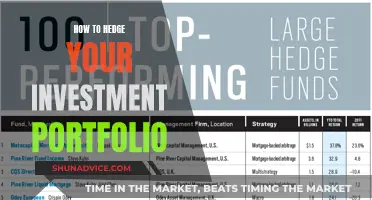
Investing your small savings can be a great way to make your money work for you. However, it's important to understand the basics of investing and the potential risks involved.
Investing is different from saving, as it involves trying to make your money grow by buying assets that you believe will increase in value over time. This could include stocks, property, or shares in a fund. On the other hand, saving typically involves putting money aside in a bank account to pay for specific expenses or goals, such as an emergency fund, a holiday, or a deposit on a home.
When deciding whether to invest or save, it's crucial to consider your financial goals and time horizon. If you're saving for a short-term goal, such as an emergency fund or a purchase within the next five years, it's generally recommended to stick with savings accounts. However, for medium to long-term goals, investing may be a suitable option, as it offers the potential for higher returns over time.
Before investing, it's important to have a solid financial foundation. This includes paying off high-interest debt, building an emergency fund, and ensuring you have sufficient savings to cover any unexpected expenses.
There are various ways to start investing with small amounts of money. This could include investing in the stock market through exchange-traded funds (ETFs) or mutual funds, using a robo-advisor, enrolling in an employer-sponsored retirement plan, or even starting your own business.
It's important to remember that investing carries risks, and there are no guarantees of returns. The value of your investments can go up or down, and you may end up with less money than you initially invested. Therefore, it's crucial to do your research, understand your risk tolerance, and seek professional advice if needed.
| Characteristics | Values |
|---|---|
| Risk | There is always a risk of losing money when investing. |
| Research | Researching the market and different investment options is crucial before investing. |
| Time | Investing is recommended for the long term (5+ years). |
| Amount | You can start investing with a small amount of money. |
| Diversification | It is important to diversify your investments to lower risk exposure. |
| Goals | It is important to set clear financial goals and timeframes before investing. |
| Professional Advice | Consider seeking advice from a financial professional before making investment decisions. |
What You'll Learn

Stocks and shares
Set clear investment goals
Be specific about your objectives. For example, instead of saying "save for retirement", set a target like "accumulate $500,000 in my retirement fund by age 50". Also, determine your investment horizon by assessing how long you have to achieve each goal. Generally, longer time horizons allow for more aggressive investment strategies, while shorter ones may require a more conservative approach.
Determine how much you can afford to invest
Take a clear-eyed look at your finances and decide how much money you can comfortably invest in stocks. Make sure you are not dipping into funds that you need for expenses. It's also recommended to have an emergency fund in place before investing, covering a few months' worth of essential expenses.
Assess your risk tolerance
Consider how comfortable you are with the ups and downs of the stock market. Are you willing to take on higher risks for potentially greater returns, or do you prefer stability? Your risk tolerance will influence the types of stocks and investments you choose.
Choose an investment account
You can invest through a regular brokerage account, a retirement account, or a managed account. Evaluate the tax implications of each option, as well as account fees, commissions, and minimum investment requirements.
Fund your stock account
You can fund your stock account through a bank transfer, check deposit, or by transferring funds from another brokerage account. Consider setting up automatic contributions to invest a fixed amount of money at regular intervals, regardless of market conditions.
Pick your stocks
Look for stocks that offer stability and the potential for steady growth, especially if you are a beginner. Some types of stocks to consider include blue-chip stocks (shares of large, well-established companies), dividend stocks (companies that pay regular dividends), growth stocks (higher risk but higher growth potential), and defensive stocks (industries that tend to do well during economic downturns).
Monitor and review your investments
Stay informed about the global economy, industry trends, and the companies you invest in. Use stock simulators to practice trading without risk, and consider diversifying your portfolio by investing in different asset classes to reduce risk. Regularly review your investment goals and adjust your strategy as needed.
Maximizing Savings: Strategies to Double Your Money
You may want to see also

Savings accounts
There are different types of savings accounts, each with its own advantages and disadvantages. Here are some of the most common ones:
Standard Savings Accounts
Standard savings accounts are a safe and liquid option for your money. They offer a modest return on your investment, but you can rest assured that your capital is secure. This type of account is ideal if you need access to your funds in the short term, such as for a vacation or a down payment on a house.
High-Yield Savings Accounts
High-yield savings accounts offer a higher interest rate than standard savings accounts, resulting in greater returns on your investment. However, they may require a larger initial deposit and may have limited access. Many banks offer these accounts to valued customers with existing accounts. It's important to note that these accounts usually have a maximum insurable amount, such as $250,000 per depositor per bank.
Money Market Deposit Accounts
Money market deposit accounts typically require a minimum initial deposit and balance, and there may be restrictions on the number of monthly transactions. They offer lower interest rates compared to some other options, but your cash remains easily accessible. These accounts are FDIC-insured, providing an added layer of security for your funds.
Certificates of Deposit (CDs)
Certificates of Deposit (CDs) are available through banks and credit unions and are FDIC-insured. They generally offer higher interest rates, especially for larger and longer deposits. However, you must keep your money in the CD for a specified period; otherwise, you may incur a penalty. Popular maturity periods include six months, one year, and five years.
No-Penalty Certificates of Deposit (CDs)
No-penalty CDs are a variation of traditional CDs that allow you to withdraw your money without paying a fee before the maturity date. This type of account is attractive during periods of rising interest rates, as you can move your funds to take advantage of higher returns elsewhere. CDs are generally less liquid than other bank investment options, but no-penalty CDs provide more flexibility.
When choosing a savings account, it's important to consider factors such as interest rates, accessibility, and any restrictions or penalties. Additionally, look for accounts that are FDIC-insured or NCUA-insured to ensure the safety of your funds. By selecting the right savings account for your needs, you can make the most of your small savings and watch your money grow over time.
Yotta Savings: A Smart Investment Strategy for Your Money
You may want to see also

Property
Investing in property is a great way to build wealth and generate passive income. Here are some strategies to consider when investing your small savings in property:
Rental Properties
Investing in rental properties is a good option for those with DIY skills, patience, and time to manage tenants and property maintenance. While financing can be obtained with a low down payment, substantial cash is needed for upfront maintenance and vacancy periods. Rental properties provide regular income, potential appreciation, and tax-deductible expenses. However, managing tenants can be tedious, and unexpected costs can eat into profits.
Real Estate Investment Groups (REIGs)
REIGs are ideal for investors with capital who want to own rental properties without the hassle of hands-on management. REIGs pool money from multiple investors to purchase rental properties, similar to a mutual fund. A company manages the properties, collecting a percentage of the rent in exchange. REIGs offer a more hands-off approach, providing income and appreciation with fees similar to mutual funds. However, investors are susceptible to unscrupulous managers.
House Flipping
House flipping involves buying undervalued properties and quickly reselling them for a profit. It requires significant experience in real estate valuation, marketing, and renovation. Flippers aim to sell properties within six months, but those who invest in renovations may take longer. While house flipping can offer significant returns, it requires deep market knowledge, and hot markets can cool unexpectedly.
Real Estate Investment Trusts (REITs)
REITs are ideal for investors seeking portfolio exposure to real estate without traditional transactions. REITs are corporations or trusts that use investors' money to purchase and operate income-producing properties. They are bought and sold on major exchanges, and by law, 90% of taxable profits must be paid out as dividends. REITs provide regular income, entry into non-residential investments, and liquidity for some exchange-traded trusts. However, investors face the risk of a real estate market downturn and liquidity risk if the REIT is thinly traded or not publicly traded.
Online Real Estate Platforms
Online real estate platforms, also known as real estate crowdfunding, allow investors to join others in funding large commercial or residential deals. These platforms pool resources from investors seeking opportunities and those seeking financial backing. Investors can diversify their real estate investments geographically but tend to be illiquid with lock-up periods, and management fees reduce profits.
Equity Linked Savings Schemes: A Smart Investment Guide
You may want to see also

Pensions
- Defined benefit schemes: In these schemes, the trustees decide how to invest your money to provide a promised retirement income. You don't need to make investment choices, but you may need to if you decide to boost your pension with additional voluntary contributions.
- Defined contribution schemes: Here, you build up a pension pot, and your money is usually invested in one or more funds. Depending on the fund, your money could be invested in property, shares, bonds, or a mix of different types of investments. If you're in a workplace pension, your money is typically invested in a default fund chosen by the pension scheme. You can stick with this fund or choose a different one, such as an ethical or socially responsible fund.
- Pensions you set up yourself: When setting up your own pension, you'll usually need to choose how to invest your money upfront. Pension providers will offer different investments and levels of support. If you want to invest in an ethical, socially responsible, or Sharia-compliant fund, make sure to choose a provider that offers these options.
- Self-invested personal pensions (SIPPs): SIPPs are a type of DIY pension where you choose your own investments. You can either contribute monthly or with a lump sum. SIPPs have tax benefits, and you can gain access to your money from age 55, usually with 25% tax-free. However, there are fees to consider, such as platform charges, buying/selling fees, fund management charges, and transfer-out fees.
- Investment choices: When deciding how to invest your pension funds, consider your attitude to risk, where your pension is currently invested, how you plan to take your benefits, and when you plan to access your savings. Cautious investors typically go for lower-risk funds like cash or bonds, while adventurous investors are prepared to take more risk and invest in equities. Medium-risk funds aim to balance risk and growth by investing in a mix of equities, bonds, property, and cash.
- Review your investments regularly: It's important to review your investment choices at least once a year to ensure they still align with your risk tolerance and goals. This is especially important as you get closer to retirement.
Investing Life Savings: Strategies for Long-Term Financial Growth
You may want to see also

Mutual funds
- Decide between active and passive funds: Actively managed funds are managed by professionals who research and buy with an eye toward beating the market. Passive investing is a more hands-off approach, often involving index funds or ETFs, which carry lower fees.
- Calculate your investing budget: Consider how much money you have to invest comfortably, as well as the minimum investment amount required by the fund.
- Decide where to buy mutual funds: You could buy directly from the fund company, but this limits your choices. You could also work with a financial advisor, but this may incur additional fees. Most investors opt for an online brokerage, which offers a broad selection of funds.
- Understand mutual fund fees: Mutual funds charge an annual fee, or expense ratio, for fund management and other costs. This is expressed as a percentage of your investment and should be considered when choosing a fund.
- Manage your mutual fund portfolio: Consider rebalancing your portfolio annually to keep it in line with your diversification plan. Avoid chasing performance or making investment decisions based solely on short-term returns.
Pros
- Diversification: Mutual funds provide instant diversification, reducing risk by spreading your investment across many different securities.
- Liquidity: Mutual funds are highly liquid and can be bought and sold relatively easily.
- Professional management: Mutual funds are managed by professionals, giving small investors access to skilled money managers at a low cost.
- Variety: Mutual funds offer a wide variety of investment options, allowing investors to gain exposure to different assets and investment strategies.
Cons
- Fees: Mutual funds charge various fees, including expense ratios, sales charges, redemption fees, and account fees. These fees can eat into your returns over time.
- Cash drag: Mutual funds need to hold a significant portion of their portfolios in cash to satisfy share redemptions, reducing potential returns.
- Performance: There is no guarantee that actively managed funds will beat the market, and they often come with higher fees.
- Lack of transparency: It can be challenging to compare funds due to a lack of transparency in holdings and performance metrics.
Invest Your Savings Wisely: A Guide for Nigerians
You may want to see also
Frequently asked questions
You can start investing with a small amount of money by enrolling in your 401(k) or a similar retirement plan at work. You can also try the cookie jar approach, where you save a small amount of money each week and put it in a high-yield savings account (HYSA).
Some common mistakes to avoid when investing include not investing early enough, trying to time the market, getting involved in shady investments, and putting all your eggs in one basket.
There are several ways to invest small amounts of money, including investing in mutual funds or ETFs, letting a robo-advisor invest for you, and investing in your own business.







